Janapada Sampada
Bamboo And Cane Culture Of Assam
Introduction

Fine Basket, Bamboo
Assam is rich in sylvan resources and most of its forests are richly stocked with bamboos and canes of various species. Bamboo is a raw material of great versatility and forms an integral part of the lifestyle and economy of Assam. Special mention may however be made of the forests of Mizo Hills, Cachar, Mikir and North Cachar Hills, Nowgong and Lakhimpur districts. While touring in the hill districts, one sometimes wonders at the vast expanses of bamboos and canes. The important species of bamboos of economic value are the Muli (Melocanna bambusoides), Dalu (Teinostachyum dalloa), Khang (Dendrocalmus longispatnus), Kaligoda (Oxytenanthera nigrociliata) and Pecha (Dendrocalamus Hamilton-ii). The Muli and the Dalu have great commercial importance, the former for pulping, constructional and fencing purposes, and the latter for the mat and basket industry.
The making of bamboo and cane products is perhaps the most universal of all the crafts practiced by a large number of artisans scattered throughout the State. It is practiced as a household industry and no mechanical device is used. Cane and bamboo products are used for a wide range of purposes and extensively used in every household.
This industry has carved for itself an important place among the handicrafts of the State. It provides part time employment to the cultivators in their spare time, and full time employment to the few highly skilled artisans who produce only fine decorative baskets, furniture and mats on a commercial basis.
History and Origin
No definite records are available to establish the antiquity, history and origin of this craft in Assam. However, it can be safely assumed that the craft was practiced since the misty past with the very dawn of civilization. In the early period in Assam, bamboo was held with special reference and is forbidden to cut in “auspicious days”. It is a general belief that bamboo possesses auspicious character and is of religious significance.
An idea about the flourishing state of cane and bamboo products of Assam was fond even during the time of Bhaskara Varman (early part of the 7th century A.D.), the king of Assam, may be had from the following extract. (An extract from “The History of Civilization of the People of Assam” by Dr P.C. Chouudhury.)
“Early literature refers to the well-decorated and coloured sital patis (cool mats) used by the rich people. Mats were usually made of cane. The classical writers testify the abundance of cane in the forests of Assam. Ptolemy, for instance, states that to the east of Serica, which we have identified with Assam, there were hills and marshes where canes were grown and used as bridges. Evidence of the production of other cane articles is also supplied by the ‘Harshacharita’, which mentions stools of cane. The cultivation of bamboo and its use for various purposes are well known. Bana again testifies to this highly developed craft. He states that Bhaskara sent to Harsha ‘baskets of variously coloured reeds’, ‘thick bamboo tubes’ and various birds in ‘bamboo cages’. All these prove that various industrial arts were developed in Assam at an early period and were continued to be practiced till recent times, based on that traditions like those of the craftsmen of other parts of India…”
Distribution According to Caste or Community
It is observed that there is no particular caste or community in the Assam Valley who are exclusively connected with this traditional craft. It is generally carried on by all, particularly the peasants irrespective of caste, community or creed.
Technique of Production
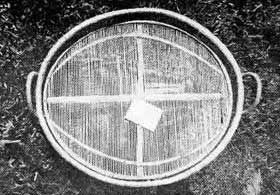
Tea Tray, Bamboo
Raw materials and their uses:
Assam has probably the maximum resources for the cane and bamboo industry in India, comparable with Canada and the Scandinavian countries-Sweden, Norway and Finland. In bamboo and reeds, Assam has the most concentrated forests in the whole of India. As many as 51 species of bamboo grow in Assam and they are being used for diverse purposes, mainly for buildings, furniture and diverse contraptions. Studies are being conducted in some research centres in India as to the suitability of the bamboo being used as a reinforcement to replace mild steel bars in light concrete structures. Bamboo is also used for umbrella handles, walking sticks, tool handles, fishing rods, tent poles, cordage, ladders, yokes, baskets, toys, hand-fans and various domestic and agricultural implements. All these articles can be produced on a cottage and small-scale basis with small machineries.
Bamboo
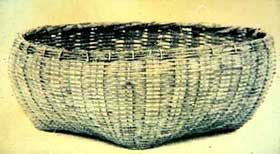
Bamboo Basket, Silchar, Assam
At present, there are vast untapped resources of bamboo that can open avenues for utilization of bamboo for many productive works. Such a huge surplus of bamboo is not to be found elsewhere in India. The prospects of establishment of several pulp and paper plants, big and small, on bamboo alone, is tremendous. The important species mentioned below are available in commercial quantities.
1. Muli (Malocanna Bambusoides).
2. Hill Jati (Oxytenanthera Parvifola)
3. Kako (Dendrocalamus Hamiltoni)
4. Dalu (Teinostachyum Dalloa)
Apart from forests, bamboo is also plentiful in the villages throughout the State. Even though Assam has been traditionally rich in bamboo, bamboo craft from Assam do not figure prominently in the handicraft market of India and Assam’s share in the export trade is negligible.
Cane
Various cottage and small-scale industries in Assam are dependent on the supply of different kinds of cane and reeds. It is observed that generally three species of cane are exploited in commercial quantities- Jati (Calamus tenuis), Tita (Calamus leptesadix) and Lejai (Calamus floribundus). Some less important qualities like Sundi (Calamus garuba) and Raidang (Calamus flagellum) are also extracted.
Cane is also found in abundance almost throughout the state. There are a few more varieties of bamboo and cane used for manufacturing of different products. A kind of muli bamboo locally known as ‘muli bazail’ is used for making umbrella handles. Two other varieties of bamboo locally known as ‘Mrithinga’ and ‘Bethua’ and different varieties of canes locally known as ‘sundi’, ‘barjali’, ‘harua’, ‘golla’ etc. are required for making furniture and baskets.
‘Murta’ (Clinogyne Dichotoma), a plant of the reed family or patidai, is required for making the famous “Sital Pati” (cool-mat).
For manufacture of ‘japis’ (umbrella), a type of palm leaves locally known as “tokow pat” are used. A ‘fulam japi’ (decorated bamboo umbrella) requires, besides palm leaves, coloured wool, cotton, dyed yarn, mica, etc. for colouring and varnishing of their products, the artisans use the following materials- ‘bhatar phen’ (boiled rice juice), ‘amrapata’ (Hibicus Subdariffa), ‘tamarind leaves’, mezenta (a kind of chemical dye stuff), kalabati chach (lac) resin, methylated spirit, rabi mustafi, etc.
Tools and Implement
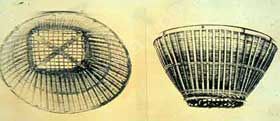
View of the inside wall and the square base
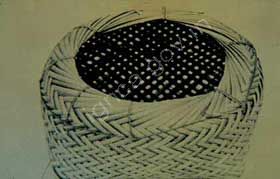
Bamboo Basket, Silchar, Assam
In the sphere of bamboo and cane works simple and inexpensive used throughout the state. The essential tools required for bamboo craft consists of a ‘dao’ (bill-hook), a knife and a ‘jak’ (‘v’ shaped wooden frame). In manufacturing cane products also, ‘daos’ and knives are mainly used, and only the furniture making establishments use a few saws, hammers, pliers and pincers in addition to daos and knives. A few more hand tools are found to be employed in the manufacture of bamboo umbrella handles. The tools and implements used in the craft are ‘bakai kol’ (bending frame), ‘narum’ (sharp and pointed carving blade), files, saws, knives, blowpipes, tongs, oven, etc.
Workshed: The manufacture of cane and bamboo products are mostly carried on outdoors and the craft does not require any housing arrangement particularly in rural areas. In the urban areas, however, it is found that cane products are manufactured in workshops and the majority of the establishments are housed in rented buildings.
Products and Process of Manufacture
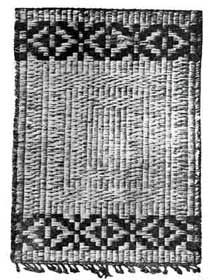
Cane Mat
Various types of cane and bamboo products are found in this state. The people of the plains and hills districts of Assam have their own bamboo and cane products with distinctive features and typical designs. The products of the plain districts differ from that of the hill districts in use, shape and design.
It is found that a variety of products like bamboo mats, sital pati, baskets of various sizes and shapes, winnowing trays, sieves, japi or chatta, various types of fishing implements, etc. are manufactured in large numbers in the plains districts of the state. The cane and bamboo products used for domestic purposes are prepared in every nook and corner of the state out of split bamboo and fine flexible cane strips.
Bamboo and Cane products manufactured for use in domestic purposes
I. A brief description of some cane and bamboo products manufactured for use in domestic purposes is given below:
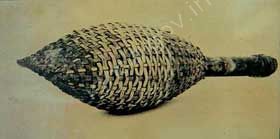
Unusual Basket from Kheruni Village, in Mikir Hill, Assam
Chalani (sieve)
It is woven with fine bamboo slips in a criss-cross way, keeping some open spaces between the different slips as required for different purposes. The ‘chalani’ is a round-shaped disc-like object and its diameter varies from 1˝ ft- 3˝ ft. It is used sieving rice, paddy, tea-leaves, etc. and also for washing fish.
Kula (winnowing fan)
It is prepared out of flat bamboo slips for winnowing purposes in different sizes and shapes. Twilled design is used for a ‘kula’. The edge of the ‘kula’ is made strong by fixing of two sets of one-inch wide bamboo pieces wrapped up in flexible cane strips.
Khorahi (small basket)
Khorahi is made of fine bamboo splits for washing rice, vegetables, fish, etc. It is a small basket-like thing with provision to allow water and dirt to pass out. The Khorahi is woven in plain and square form but is gradually bent in a round form at the time of final stitching by flexible cane slips.
Dukula / Tukuri (Big basket)
The shape of a dukula is exactly the same as that of the Khorahi, but the size and process of preparation is a bit different. The required shape of a ‘tukuri’ is made by bending the bamboo splits forming the warp gradually when the process of weaving with the weft is in operation. Fixing two or four flat bamboo strips strengthens the edge. The last stage is to stitch the edge along with those flat bamboo strips with some flexible cane slips. The size of a ‘dukula’ or a ‘tukuri’ is much bigger than that of the Khorahi and is used for carrying as well as keeping paddy, rice, etc
Dala (bamboo tray)
Dala is prepared out of flexible bamboo slips in twilled design. The shape of a dala is exactly like a disc with various sizes for different purposes. The edge around the dala is stitched in the same way as that of the edge of a tukuri or dukula, but the bamboo rims used in the edge of the dala is about 1˝”. The dala is used specially for rearing silk worms and for winnowing in addition to other domestic purposes.
Duli (Assamese) / Tali (Bengali) – Big Basket
The ‘duli’ or ‘tali’ are used for preserving paddy. The process of weaving is almost the same as that of a tukuri but the size of bamboo slips used is more flat and flexible. The dulis are much bigger than the tukuri and the shape is a bit different too.
Doon (Assamese) Kathi (Bengali)-Measure
It is prepared in an almost conical shape with fine bamboo strips for measuring rice or paddy. Its holding capacity varies from 2 seers- 3˝ seers from place to place. A ring is attached at the bottom to enable it to stand on the ground.
Dhol (big measure)
The process of preparation of ‘dhol’ is just like that of the doon. However, it is much bigger in size. It is used for measuring paddy only. In the Cachar district, it is known as ‘pura’. This is not generally bought or sold in the markets.
Fishing Implements
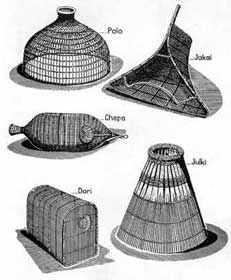
There are various kinds of fishing contraptions prepared out of cane and bamboo in different parts of the state. A brief description of some of the fishing implements widely used like polo, Jakai, Khalai, Dori, Chepa, Paran, Jhuti, Hogra, etc. is given below:
Polo
It resembles the shape of a dome with short stem of about 6″ diameter open at the top. The diameter at the bottom varies from 2 ft-3˝ ft. and even upto 4 ft. and the height varies from 2 ft. to 3 ft. It is prepared out of small bamboo strips fastened with fine and flexible cane slips. Polo is used for fishing in shallow water. The man who uses it hold it by the side of the stem, presses its rim on the mud, then pulls it back and lifts above or up to the level of water and again presses it as before while moving on through water. Whenever any fish is caught, he puts his hand inside through the stem to catch hold of the fish; julki is a small polo prepared in the same fashion.
Jakai
The ‘jakai’ is a species of wicker work shovel that is either dragged along the bottom or placed on the water bed to catch the small fishes which take refuge in it when the weed is trampled. It is prepared with bamboo slips, which are locally known as ‘dai’. ‘Jati’ bamboo is specially used for making this particular implement.
Khalai
The ‘khalai’ is also prepared with bamboo strips. The strips required for the weft are very long, while those for the warp are short. The ‘khalai’ is woven in the shape of an earthen ‘kalasi’ or pitcher. This is used for temporary keeping of fishes during hand-net fishing.
Chepa
The Chepa is made of some prepared bamboo rods according to required size. These are woven in a roundish fashion with jute string or soft cane slips. A bamboo-made valve locally known as ‘par’ (Bengali) and ‘kal’ (Assamese) is fitted in the middle of the chepa to allow the fishes to enter inside with no scope for going out.
Dori
Fishermen in the rural areas of the state manufacture dories of various types. A ‘dori’ is generally rectangular. It is prepared out of small bamboo strips woven with flexible cane slips. A trap is fitted with a ‘dori’ in such a way that a bamboo-made screen is prolonged inwards from either side of the oval mouth and the pointed splints of the two sides interlock together.
Parans
These are various cages or basket traps made of bamboo splits used for catching fishes. There are two kinds of ‘parans’, namely (i) ‘uba paran’ (vertical cage) and (ii) ‘pora paran’ (horizontal cage). These are provided with one or two valves or trap doors through which fishes can be easily trapped.
All these implements mentioned above are generally used in catching fishes in shallow water. Apart from these contrivances, there are some other implements made of bamboo and cane and are used for catching fishes in deep waters. These are locally known as gui, jhuti, dingaru, thupa, hogra, etc.
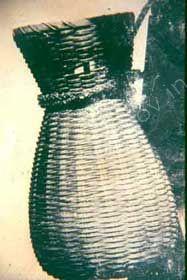
Plain Basket, Assam (Used by the Bodos to keep catch while fishing)
Bamboo Mats
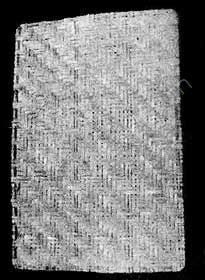
Finished ‘Dhari’ or bamboo mat
Bamboo mats of various types are manufactured on a commercial basis in the districts of Nowgong, Darrang and Cachar. Large-scale commercial production can be seen from Karimganj sub-division of the Cachar district where mats are locally known as ‘dhara’, ‘jharia’ or ‘darma’, and thousands of people are engaged in this craft. In the districts of Darrang and Nowgaon, such mats are produced from the dried stalks of various kinds of marshy plants and weeds. While in the district of Cachar, it is produced out of bamboo slips.
Observation on the manufacturing process as recorded here is taken at a village of Cachar. To start with, long bamboos are cut into several parts according to the desired length of the mats to be woven. Then each part is splitted into several thin pieces, the breadth of such pieces being about 1/8″ to 1/16″. Splitting is generally done by a ‘hatu dao’ (small bill hook), which is fixed on a ‘jak’ (‘v’ shaped wooden frame). Then the soft portion of such bamboo split is removed with a ‘dao’, whereupon the flat flexible bamboo strips are obtained for manufacturing mats.
Thus with the bamboo slips ready, the artisans commences actual weaving. In weaving bamboo mats, generally the twilled pattern is followed wherein three slips are taken at a time and woven breadth wise one after another and the same process is repeated. As soon as weaving is complete, all the four sides of the mat are twisted a little and tide up with a long bamboo slip in order to frame the outer edges which keeps the woven slips compact.
This craft is found to be carried on by all the members of the artisans-family/men preparing the bamboo slips, women, and children weaving the mats. Bamboo mats are extensively used for various purposes like construction of temporary walls and sheds, big pandals, roofing of country boats, dwelling houses etc. besides, domestic uses, mats are also required by big mills and factories for various uses.

A lady engaged in Mat Weaving
Umbrella handle
A special variety of muli bamboo locally known as muli-bazail is used for umbrella handles. There are different processes involved in manufacturing umbrella handles. First, the uppermost chamber of the bamboo pieces, sorted out for use, is filled with sand so that it may not crack at the time of bending. The mouth of the top chamber so filled up is then sealed with cowdung. Next comes the bending operation which is generally done with the help of a bending hand-tool locally known as ‘bakai-kol’. The upper portion of the bamboo is pressed into the ‘bakai-kol’ after getting it red-hot while holding tightly the bamboo with a pair of tongs. After a few minutes, the bamboo is removed from the ‘bakai-kol’ and the bent portion of the umbrella handle is tied with a rope and kept in shade for sometime to allow it to cool down. The edge of the ‘U’ bend is then cut in a uniform manner and the opening is plugged with a thin piece of reed locally known as ‘gollar doga’ to prevent the filled up sand coming out of the handle. The sand thus remained minimizes the chance of cracking or splitting of the bend. The plugged portion is smoothened with an iron file. Now the rough surface of the umbrella handle is smoothened with a sharp knife, locally known as ‘chacha’, followed by carving out or scratching various designs on the handle. These are scooped out by swift and deft strokes of a sharp and pointed blade locally known as ‘narain’ or in some, cases, with a hand tool known as ‘rally machine’. A few of the various designs depicted are of flowers, creepers, leaves, plants, ring etc. It is observed that the female members of the artisan families exclusively perform the design work. As soon as the design work is over, the surface of the umbrella handle is polished with ‘sirish’ ‘glass paper’ followed by the application of varnish and spotting the handles with castor oil flames blown with the help of blow pipes. The handles made as such are then ready to be sent to the market, packed up in bundles of grosses.
‘Japi or Chhata’ (Bamboo / leaf head-gear)
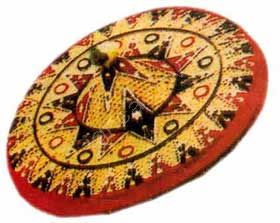
“Japi” or Head Gear
Bamboo and leaf headgear is the most indispensable item of the open air workers. Such ordinary headgears are produced throughout the State. ‘Chhatas’ on commercial basis are largely produced in some villages (e. g. Rangpur, Chinipatan, etc.) of Cachar district and supplied mainly to neighboring tea-gardens and some parts of Nowgong district. The products are generally carried on shoulder loads to the nearby ‘hats’ and sold to consumers in retail or to middlemen in bulk.
Many varieties of ‘Japis’ such as ‘halua japi’, ‘pitha japi’, ‘sorudoiya japi’, ‘bordoiya japi’, ‘cap japi’, etc. are produced in the districts of Kamrup, Nowgong, Darrang, Sibsagar and Lakhimpur. Nalbari and its neighbouring villages (such as Kamarkuchi, Mughkuchi, etc.) of Kamrup district deserve special mention in respect of manufacturing of ‘fulam japis’ (decorated bamboo umbrellas). In olden days, this particular type of ‘japis’ served as headgears for the females of noble and rich families, but now it has become outdated. Productions of ‘fulam japis’ are now only intended to serve as items of drawing-room decorations.
This traditional headgear (japi) is made of strips of bamboo and a special kind of dried palm leaves locally known as ‘tokow-pat’. The manufacture of ordinary ‘japi’ does not require any special skill. First of all, the selected bamboos are split into small strips of required sizes. Then the strips are woven in open hexagonal design into a circular disc with a dome in the centre for the head to fit in, putting a few dried ‘tokow’ leaves (previously cut into required sizes) in between two such discs and finally sewing them securely with yarn and fine strands of cane. Thus, the manufacture of ordinary ‘japi’ is completed.
A japi is more advantageous to the cultivators and other open air workers than the conventional umbrella, because the cultivator after putting it on can tie the strings around his chin leaving his hands free to work in any position-standing, squatting or stooping. ‘Japi’ can also be called a poor man’s umbrella, because of its cheap price.
Bamboo Musical Instruments
Flute is a commonly used musical instruments made out of bamboo. Besides this, other musical instruments like bamboo beater, do-tara etc., are used in the Bihu festival of Assam. “Gogona” is another musical instrument shaped from a thick bamboo outer split, so that one end forms the handle while the other end can be struck by fingers when the instrument is held against the mouth.
Folk Medicine from bamboo as used in Rural Areas of Assam
Fresh Cuts: Greenish portion of the bamboo stem is grounded and made into a paste for application over the fresh cut area. It usually serves as an antiseptic and acts fast in the wound healing process.
Early Diabetes: Water collected inside the bamboo stem when taken relieves the disease considerably.
Toothache: Toothache is relieved by heating young bamboo twigs and applying over it.
Loose Tooth: The sticky juice that comes out from burning dried bamboo is applied on the root of the tooth to make it firmer.
Hypertension: White part of the mew bamboo leaf is to be taken on empty stomach early in the morning, which helps to control hypertension.
Dandruff: The ash of clump sheath of bamboo is effective for removing dandruff.
Body pain: Sleeping in a bed made of whole bamboo relieves body ache.
Chicken pox, Small pox and Ulcers: Dried young bamboo shoot is to be grounded and taken with cooked Catfish which helps in early healing of chicken pox, small pox and ulcers.
Giddiness and Chronic Pain: Curd prepared with young bamboo shoots taken with black pepper relieves giddiness and chronic pain.
Headache and Sinusitis: Dried bamboo burnt and the inhaling of the smoke of the bamboo relieves headache and sinusitis.
Diversification in present Bamboo Industry
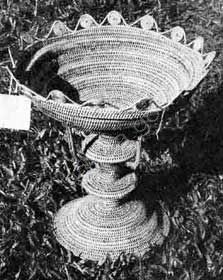
“Man-Bata” or Paan-Bata, Bamboo
Considering the present market demand and export potentiality, entrepreneurs are either proposing of starting manufacture of following bamboo products:
- Weaved bamboo blind and screen
- Barbecue sticks
- Skewers
- Fruit forks
- Party picks
- Back scratchers and ear scrappers
- Rice spoon
- Plant support sticks
- Tooth picks
- Seat cushions
- Ice-cream spoons
- Kite stick
Some other common bamboo products

“Murrah”, Bamboo (Stool)
- Bamboo brooms
- Knife handle
- Bamboo curtains
- Bamboo handbags
- Flower vases and ash trays
- Wall hanging
- Folding fans
- Walking sticks
Cane furniture
The manufacture of cane furniture, however, calls for a high degree of skill on the part of the workers. Such skill is found to be traditional. In the manufacture of cane furniture, Cachar district enjoys a special advantage over the other districts of the State as far as skilled artisans are concerned. The craft has commercial production in almost all the important urban areas of the State.
The manufacture of cane furniture starts with the preparation of requisite amount of bamboo slips. Canes of various diameters are also reduced into slips of various sizes according to adaptability. The artisans then prepare a rough structure of the furniture by joining the different bamboo parts (previously sized) with the help of nails. In case of round-cane furniture, thin iron rods are used to get the round cane bend to the required shape. The actual weaving or coiling of the structure so made is done with fine slips of flexible cane. The more skilful an artisan is, the finer slips of cane he can use in coiling and plaiting.
To meet the growing needs of the consumers, urban establishments are found to be engaged in the manufacture of various types of cane furniture and other sundry articles, like boxes, murrahs, cradles, office trays, bottle carriers, tiffin baskets, bicycle baskets, waste paper baskets, etc. The cost of such products is higher than other common bamboo products.
Cane Baskets
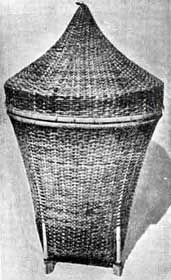
Cane Bamboo Basket lidded with dome shaped lid & square shaped bottom. (twill work technique), Guwahati, Assam
Cane baskets of various types are produced in different parts of the State. Cane baskets are used for various purposes. These are used mainly for carrying goods, storing grains and keeping valuables. The Kukis, Mikirs and Mizos specially use the baskets for keeping ornaments and clothes with locking arrangements. In the plain districts, also a few persons keep their clothes etc. in cane suitcases. Extensive manufacture of ‘plucking baskets’ is found in all the plain districts on a commercial basis. Generally, the tea planters purchase these baskets in big lots from time to time. Therefore, the manufacture of plucking baskets is a monopoly of a few big firms with substantial financial backing. These firms also manufacture various types of baskets used in the carrying of earth, coal etc. It is seen that these bigger firms obtain their supply of raw materials at much lower costs than the others do.
In Assam, baskets are prepared in different designs and by different methods. They may be prepared of both bamboo and cane or cane alone. The different methods of production is confined to the following types, e.g. (1) Plaited or woven work, (2) Wicker Work and (3) Coiled basketry.
Plaited or woven baskets
Plaited basketry consists essentially of two sets of elements (warp and weft) crossing each other. The plaited baskets are prepared in different designs such as check, twilled, twined, wrapped and hexagonal. Baskets used for keeping clothes and ornaments, cane suitcases, etc. are generally prepared in this method.
Wicker work
In wicker work, the warp is not pliable, but the weft is pliable and passed alternately over and under the warp. In this method, the warp is kept in a lesser rigidity. Plucking baskets are prepared in this method.
Coiled basketry
The warp is arranged by cane of sufficient length. Before arrangement, such cane is soaked in water for sometime to give it a flexible character. Simply binding coiled cane while the process of weaving is in operation, preserves the shape of the basket. Finally, the edge of the basket is stitched with a thin and flexible cane slip. Plucking baskets, ration baskets, baskets used for carrying earth, stone-chips, coal etc. are manufactured in this method, technically known as ‘bee-skip’ design.
Scope for development
The main raw materials for the industry, i.e. bamboo and cane of various types are abundantly available throughout the State. It requires little or no investment and can be pursued by anybody and everybody of a household as a subsidiary occupation. As such, the industry has considerable scope for development and various new products suited to modern tastes can be manufactured out of bamboo and cane. Market intelligence is required to be developed so that products can be made to cater to the need of the consumer market. State Governments Emporia are also trying to popularize a few artistic and decorative cane and bamboo products outside the State
To organize the unorganized and scattered handicraft artisans, the Government of Assam had launched a scheme for registration of handicraft artisans and handicrafts units.
GLOSSARY:
Chalani Sieve
Kula Winnowing fan
Khorahi or dhusain Small bamboo basket
Dukula or Tukuri Big bamboo basket
Dala Bamboo tray
Doon or kathi Measure
Dhara, dharia or darma Bamboo mat
Japi or chhata Bamboo and leaf head-gear
Sital pati Cool mat
Patikar Cool mat maker




